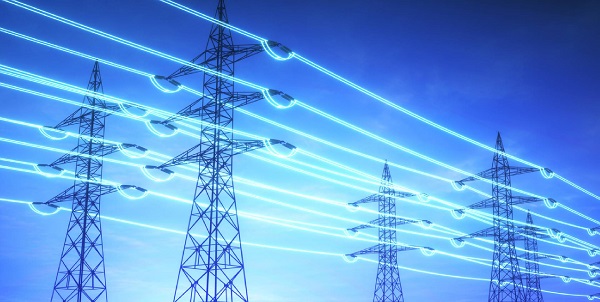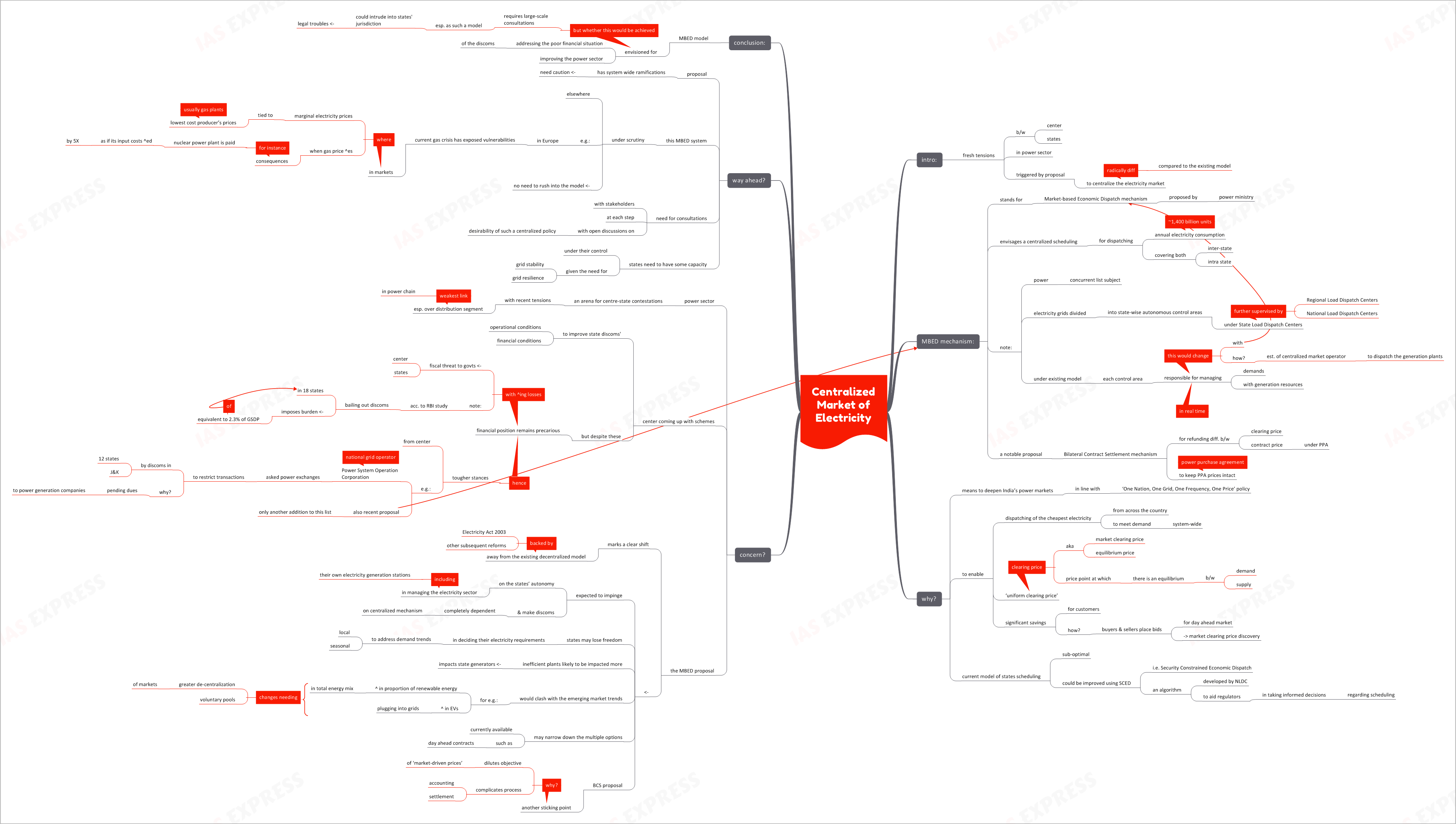Centralized Market of Electricity

The centre and state governments are facing fresh tensions over the power sector. The trigger is the Union government’s plan to centralize the electricity market- a radically different approach compared to the existing de-centralized, voluntary pool-based market.
What is the MBED Mechanism?
- MBED or Market-based Economic Dispatch mechanism, proposed by the Union Power Ministry, envisages a centralized scheduling for dispatching the entire yearly electricity consumption of 1,400 billion units.
- This scheduling is to cover both inter-state and intra-state dispatches.
- Power is a Concurrent Subject according to the Constitution. Electricity grids are divided into state-wise autonomous control areas under State Load Dispatch Centres. These SLDCs are supervised by Regional and National Load Dispatch Centres.
- Under the existing model, each control area is responsible for managing its demands with generation resources in real time.
- The MBED Model would change this by establishing a central market operator to dispatch the generation plants.
- A notable proposal under this model is the BCS or Bilateral Contract Settlement mechanism for refunding the differences between the clearing price and the contract price under the power purchase agreement (PPA), to keep the PPA prices intact.
Why is it being implemented?
- The Union Power Ministry is pitching this model as a means to deepen India’s power markets in line with the ‘One Nation, One Grid, One Frequency, One Price’ policy.
- The model could enable the dispatching of the cheapest electricity, from across the country, to meet the demand across the system.
- This model would lead to ‘uniform clearing price’. Clearing price or market clearing price or equilibrium price refers to the price point at which there is an equilibrium between demand and supply.
- The mechanism envisions that sellers and buyers place their bids for the day ahead market and lead to the discovery of market clearing price. This will generate significant savings for the electricity consumers.
- Also, the centre is arguing that the current model of states scheduling is sub-optimal. To this end, the SCED or Security Constrained Economic Dispatch, an algorithm developed by NLDC, is being considered for assisting regulators in taking informed decisions on scheduling.
Why are the states concerned?
- Over the years, the power sector has increasingly turned into an arena for centre-state contestations. Most of the recent tensions are over the distribution segment, the weakest link in the electricity chain.
- The central government has been coming up with various schemes to improve the financial and operational conditions of the state discoms. Despite these multiple attempts, the discoms’ financial position remains precarious, with mounting losses posing fiscal risks at state and central government levels.
- According to an RBI study, bailing out discoms in 18 states would potentially impose a burden equivalent to 2.3% of GSDP of these states.
- Considering such implications of these discoms’ weakening finances, the government has been resorting to tougher stances. For instance, the national grid operator (Power System Operation Corporation) asked power exchanges to restrict transactions by discoms in 12 states and J&K, because of their pending dues to power generation companies.
- The recent proposal for a centralized market is only the most recent addition to this list of contestations.
- This proposal marks a clear shift away from the existing decentralized model backed by the Electricity Act of 2003 and other subsequent reforms.
- Experts say that this will impinge on the states’ autonomy in managing the electricity sector, including their own electricity generation stations, and make the discoms completely dependent on a centralized mechanism.
- This would mean that the states would lose their freedom in deciding their electricity requirements to address local and seasonal demand trends.
- Some argue that inefficient plants are likely to be significantly impacts by this shift and disproportionately impact the state generators.
- There are concerns that the proposed model would clash with the emerging market trends. For instance, the proportion of renewable energy is increasing in the overall power generation mix and an increasing number of EVs are increasing the demand from the grids.
- Such market trends necessitate a greater de-centralization, not centralization, of markets and voluntary pools to improve the efficiency of grid operation and management.
- It is also possible that the MBED model may narrow down the multiple options, currently available under the voluntary market model. Eg: the day ahead contracts would turn redundant.
- The BCS proposal is another sticking point for it dilutes the objective of ‘market-driven prices’ and complicates the accounting and settlement process.
What is the way ahead?
- The proposed MBED mechanism has system-wide ramifications, with the operations and infrastructure of the players facing significant changes, and hence, there is a need for caution.
- Also, this framework is under scrutiny worldwide. For instance, in Europe, the current gas crisis has exposed the vulnerabilities in such markets where the marginal electricity prices are tied to the lowest cost producer’s prices (usually a gas plant). However, when the gas prices increase, there are consequences- for instance, a nuclear power station is paid as if its input costs had spiked 5X. Hence, it isn’t wise to rush into the MBED model.
- Before implementing such a model, there is a need to consult all the stakeholders at each step of the process. The consultations should include open discussions on the desirability of such a centralized policy itself.
- From the perspective of grid stability and resilience, it is necessary for the states to have some capacity under control.
Conclusion:
The MBED model has been envisioned for addressing the poor financial situation of the discoms and improving the power sector as a whole. However, whether it could actually achieve these objectives is something that requires large-scale discussions with the stakeholders, especially as such a centralization could intrude into the states’ jurisdiction, leading to legal troubles.
Practice Question for Mains:
What is the MBED Model? Discuss its pros and cons. (250 words)
If you like this post, please share your feedback in the comments section below so that we will upload more posts like this.


